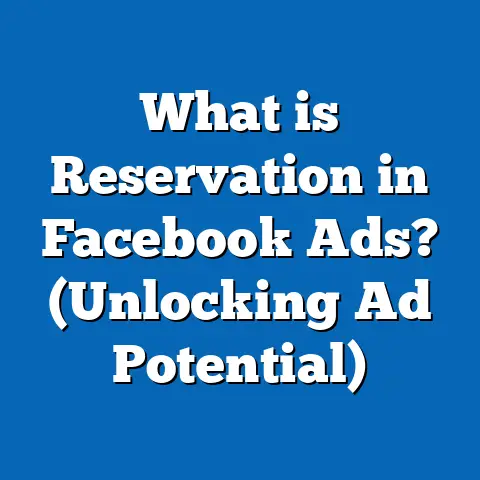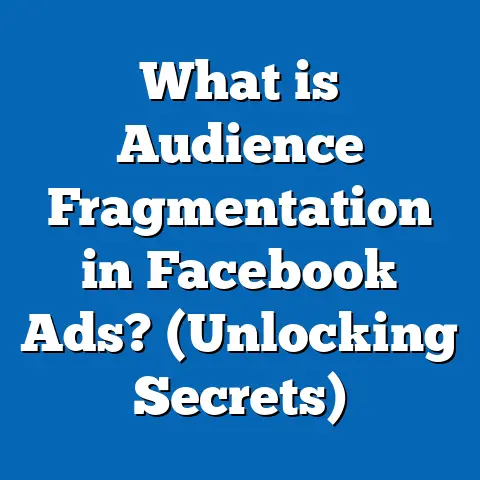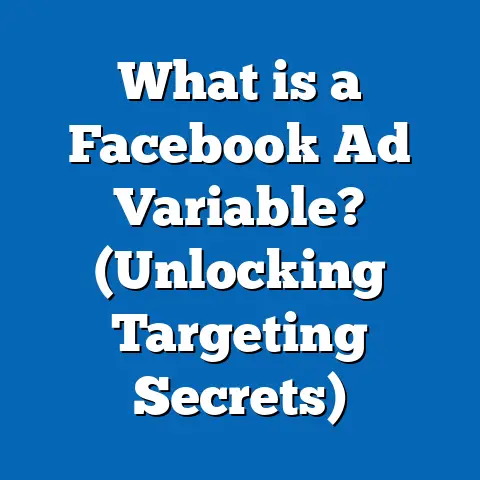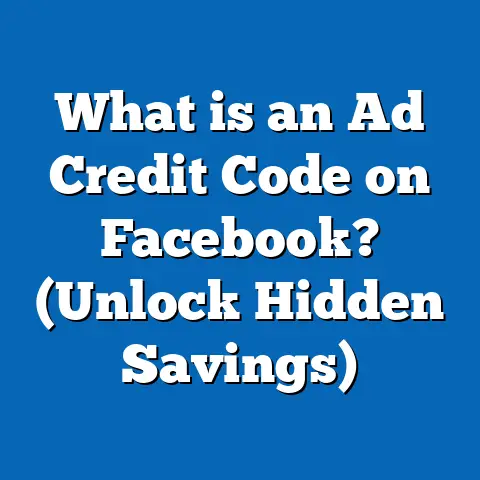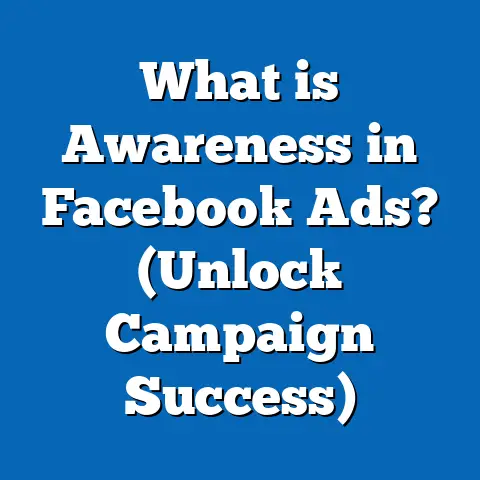What is Auction and Reservation in Facebook Ads? (Unlock Success)
What is Auction and Reservation in Facebook Ads? (Unlock Success)
Introduction: Are You Leveraging the Full Power of Facebook’s Auction and Reservation Systems?
In the fast-paced world of digital marketing, understanding how Facebook’s ad delivery system works can be the difference between wasted budget and significant ROI. Have you ever wondered why some ads on Facebook perform stunningly well while others barely get any traction? The secret often lies in mastering Facebook’s Auction and Reservation systems. These two methods control how your ads get placed, who sees them, and how much you pay. If you want to optimize your Facebook advertising strategy, understanding these systems is essential.
This guide will provide a thorough breakdown of these two buying methods, explore their differences, dive deep into how they work, share data-backed insights and real-world examples, compare them with other platforms, and reveal advanced strategies for success.
Understanding Facebook Ads Buying Methods: Auction vs. Reservation
Facebook Ads operate primarily through two buying methods: Auction and Reservation. Both offer unique advantages depending on your advertising goals, budget size, audience targeting needs, and campaign objectives.
What is Facebook Ads Auction?
The auction is the default buying method on Facebook Ads. It’s a real-time competitive bidding process where advertisers compete to show their ads to a specific audience.
- How It Works: When an ad space becomes available for a user’s feed or story, Facebook runs an auction among all advertisers targeting that user.
- Advertisers submit bids based on their campaign goals (clicks, impressions, conversions).
- Facebook evaluates each bid by combining bid amount with ad quality and predicted action rate.
- The winning ad is shown to the user.
- The advertiser pays only what is necessary to outbid the next highest bidder (second-price auction model).
What is Facebook Ads Reservation?
Reservation buying, also called Reach and Frequency (R&F) buying, allows advertisers to book ad space in advance at a fixed price.
- Instead of competing in an auction for every impression, advertisers secure guaranteed impressions.
- This model offers predictable results — useful for campaigns requiring consistent reach over a defined period.
- Ideal for brand campaigns that need precise control over timing, frequency, and audience exposure.
Why Understanding These Two Methods Matters
Advertising on Facebook without knowing how your ads are bought can lead to inefficient spending and missed opportunities.
- Budget management: Auction offers flexible spending; reservation requires upfront commitment.
- Ad delivery control: Auction adapts dynamically; reservation locks delivery parameters.
- Performance predictability: Auction outcomes vary; reservation provides certainty.
- Campaign suitability: Some campaigns need performance flexibility; others demand brand consistency.
Marketers who master these differences gain a competitive advantage by aligning their campaigns with the buying method best suited for their goals.
Deep Dive: How Does Facebook Ads Auction Work?
Key Components of Facebook’s Auction Process
When Facebook runs an auction for an ad impression opportunity, it considers three key factors:
- Bid: The maximum amount an advertiser is willing to pay for the desired action (click, impression, conversion).
- Estimated Action Rate: A prediction of how likely a user is to take the desired action if shown the ad. This uses historical data and machine learning.
- Ad Quality: Facebook measures ad quality based on user feedback (positive or negative), engagement rates, and relevance score.
Facebook combines these factors into a total value score to decide which ad wins: Total Value=Bid×Estimated Action Rate×Ad Quality\text{Total Value} = \text{Bid} \times \text{Estimated Action Rate} \times \text{Ad Quality}
The ad with the highest total value wins the auction.
Types of Bidding Strategies in Auction
Facebook offers multiple bidding strategies that influence how your bid interacts with the auction:
- Lowest Cost (Auto Bid): Facebook automatically bids to get the most results for your budget without exceeding it.
- Bid Cap: You set a maximum bid per action; useful when controlling costs strictly.
- Cost Cap: You target an average cost per result over time.
- Target ROAS (Return on Ad Spend): Optimizes bids to meet a specific return on investment goal.
Each strategy balances cost control with delivery volume differently.
How Auction Pricing Works: Second-Price Model
Facebook uses a second-price auction system. This means:
- You pay just enough to beat the next highest bidder — not necessarily your full maximum bid.
- This system encourages honest bidding without overpaying.
- It keeps costs competitive while rewarding higher quality ads.
Data Insight: Auction Performance Statistics
- According to Facebook’s advertiser insights (2023), auction-based campaigns typically achieve:
- 15-20% lower cost per conversion when using automated bidding.
- 25% higher ad relevance scores compared to manual bid strategies.
- Dynamic auctions allow advertisers to leverage real-time demand fluctuations.
Case Study: Retail Brand Using Auction for Seasonal Campaign
A fashion retailer used the auction method during their holiday sales season. By switching from manual bidding to automated lowest cost bidding:
- Their cost per conversion dropped by 35%.
- Return on Ad Spend (ROAS) improved by 40%.
- The campaign dynamically adjusted bids during peak shopping hours for maximum visibility.
This demonstrated how auction bidding adapts to market conditions in real time.
Deep Dive: How Does Facebook Reservation Work?
What Is Reach and Frequency Buying?
Reach & Frequency (R&F) buying lets advertisers plan campaigns weeks or months ahead by reserving inventory for a guaranteed number of impressions at fixed prices.
Key features include:
- Guaranteed Audience Reach: You can guarantee reaching a specific percentage of your target audience.
- Frequency Capping: Control exactly how many times each user sees your ads.
- Fixed CPM Pricing: Lock in cost per thousand impressions upfront.
- Set Delivery Dates: Schedule campaigns for specific start and end dates without auction competition.
Why Use Reach & Frequency?
R&F buying is designed for campaigns that prioritize brand awareness and message consistency over direct performance metrics like clicks or conversions.
Benefits include:
- Predictable budget management without bidding fluctuations.
- Consistent daily delivery ensuring uniform audience exposure.
- Control over ad frequency to prevent fatigue or oversaturation.
Data Insight: Reach & Frequency Effectiveness
Facebook’s internal data shows:
- R&F campaigns can increase brand recall by up to 30% compared to auction-based campaigns due to stable frequency delivery.
- Advertisers see up to 15% higher message association when frequency caps are tightly controlled.
Example: Beverage Company Launch Using Reservation Buying
A beverage company booked an R&F campaign ahead of a summer product launch. They set a frequency cap of 3 impressions per user over four weeks and guaranteed reach of 80% of their target demographic.
Results included:
- A measurable 25% lift in unaided brand awareness through post-campaign surveys.
- High engagement rates with minimal negative feedback due to controlled frequency.
This example shows how reservation buying supports precise branding efforts.
Key Differences Between Auction and Reservation Buying
| Feature | Auction | Reservation (Reach & Frequency) |
|---|---|---|
| Pricing Model | Variable, second-price auction | Fixed CPM |
| Flexibility | High (real-time bid changes) | Low (locked in advance) |
| Control Over Delivery | Less precise | High (frequency, timing controlled) |
| Ideal For | Performance campaigns | Brand awareness/launch campaigns |
| Budget Requirement | Variable | Minimum spend thresholds |
| Audience Reach | Competitive, varies | Guaranteed reach |
| Optimization Ability | High (real-time adjustments) | Limited once booked |
| Risk Level | Moderate (subject to auction dynamics) | Low (predictable results) |
Practical Tips for Choosing Between Auction and Reservation
- Budget Size Matters:
- Small or fluctuating budgets work better with auctions.
- Large budgets seeking predictable outcomes lean toward reservations.
- Define Your Campaign Goals:
- Performance-driven goals (sales, leads) fit auctions.
- Brand awareness or product launches benefit from reservation buying.
- Timing Needs:
- Auctions allow last-minute or short-term campaigns.
- Reservations require minimum lead time for booking (often weeks).
- Audience Control:
- Use reservations when controlling frequency is critical.
- Auctions may allow higher frequency variability but more reach.
- Test & Learn Approach:
- Start small with both methods to monitor performance metrics over time.
- Use insights to allocate budget dynamically between methods.
Advanced Insights: Combining Auction and Reservation for Maximum Impact
Many seasoned marketers employ hybrid strategies that leverage benefits from both methods:
Layered Campaign Approach
- Phase One – Brand Awareness via Reservation:
- Book reach and frequency buys to saturate the target audience consistently.
- Build recall before product launches or events.
- Phase Two – Performance via Auction:
- Retarget engaged users with auction-based conversion campaigns.
- Adjust bids dynamically based on performance data.
This approach balances consistency with flexibility and maximizes overall campaign impact.
Using Data to Optimize Hybrid Campaigns
- Analyze audience overlap between reservation and auction campaigns to avoid excessive frequency.
- Use Facebook’s Analytics tools or third-party platforms for attribution tracking.
Case Study: Tech Startup’s Hybrid Strategy
A tech startup launched their new app using a dual approach:
- Booked R&F campaigns targeting early adopters for initial awareness.
- Followed up with auction-based ads targeting lookalike audiences showing high interest signals.
Result:
- Brand awareness doubled within one month.
- App installs increased by 50% while maintaining a steady cost per install.
Comparison With Other Advertising Platforms
Facebook’s combination of auction and reservation is unique compared with other major platforms:
| Platform | Buying Method | Key Difference |
|---|---|---|
| Google Ads | Auction only | Focused heavily on keyword intent; no fixed reservations available |
| LinkedIn Ads | Mainly auction; limited reservations | Higher CPC but highly targeted professional audience |
| TikTok Ads | Auction mostly | Limited reservation options; younger audience focus |
| Twitter Ads | Auction | More limited reservation options; emphasis on recent events |
Facebook’s dual model offers marketers both flexibility and predictability in one platform — a rare combination that supports diverse campaign needs at scale.
Latest Trends in Facebook Ads Auction & Reservation
Keeping up with platform changes is critical:
AI-Powered Bidding Improvements
Facebook increasingly uses AI to predict winning bids, expected performance, and cost efficiency — helping advertisers optimize auctions automatically.
Integration with Commerce Features
Facebook Shops and Instagram Shopping leverage auctions for product ads but also support reservation buys for seasonal promotions.
New Metrics for Frequency Management
Facebook now offers tools to measure “frequency fatigue” — when users see ads too often — enabling smarter cap settings in reservation buying.
Frequently Asked Questions (FAQs)
Q1: Can I switch from auction to reservation mid-campaign?
A1: No. Reservation campaigns must be booked upfront with fixed parameters; switching mid-campaign requires ending the current campaign and starting a new one.
Q2: Do reservation campaigns guarantee impressions?
A2: Yes, but only within the booked audience size and timeframe. External factors like audience availability can affect delivery slightly.
Q3: Is auction always cheaper than reservation?
A3: Not necessarily. Auctions can be cheaper during low demand but more expensive during peak times. Reservations have fixed CPMs but offer predictability.
Q4: Can small businesses benefit from reservation buying?
A4: Usually auctions are better due to flexibility and lower minimum spends; however, some small brands use reservations during key sale periods for brand awareness.
Summary: Unlocking Success with Facebook Ads Auction and Reservation
Understanding Facebook’s two primary buying methods unlocks strategic advantages:
- The auction system offers dynamic bidding flexibility suitable for performance-driven campaigns seeking cost-efficiency.
- Reservation buying guarantees fixed pricing and controlled delivery ideal for brand-building campaigns requiring consistent reach.
- Your choice depends on budget size, campaign goals, timing requirements, and audience control needs.
- Combining both methods strategically enables layered marketing approaches that maximize reach and ROI.
- Staying updated on platform trends ensures continued success in an evolving ecosystem.
Next Steps: How to Implement This Knowledge Today
- Audit Your Current Campaigns: Identify which campaigns use auction or reservation methods. Analyze their performance metrics.
- Align Campaign Goals: Define clear objectives – brand awareness? Direct conversions? Tailor buying methods accordingly.
- Set Up Test Campaigns: Run small-scale reservation campaigns alongside auctions to compare results directly.
- Leverage Automated Bidding: Use Facebook’s auto-bid strategies within auctions for optimized results without manual management overhead.
- Monitor Frequency Closely: Avoid ad fatigue by managing impressions through frequency caps in reservations or pacing controls in auctions.
- Use Analytics Tools: Utilize Facebook Ads Manager insights plus third-party tools for attribution tracking and optimization recommendations.
- Keep Learning: Follow updates from Facebook’s Business blog or industry news sources regularly as features evolve rapidly.
Bonus: Checklist for Setting Up Your First Reach & Frequency Campaign
- <input disabled=”” type=”checkbox”> Define your target audience precisely using demographics, interests, behaviors
- <input disabled=”” type=”checkbox”> Decide campaign duration and set specific start/end dates
- <input disabled=”” type=”checkbox”> Choose frequency cap based on message complexity (e.g., 2–3 views per user recommended)
- <input disabled=”” type=”checkbox”> Set budget above minimum threshold required for R&F
- <input disabled=”” type=”checkbox”> Select fixed CPM bidding option
- <input disabled=”” type=”checkbox”> Create high-quality creative assets optimized for consistent branding
- <input disabled=”” type=”checkbox”> Book campaign at least 7 days before start date
- <input disabled=”” type=”checkbox”> Monitor delivery daily; adjust future bookings based on learnings
Bonus: Tips for Optimizing Auction Bidding Strategies
- Use automatic lowest cost bidding when starting new campaigns.
- Experiment with bid caps once you understand average costs per action.
- Leverage Cost Cap bidding if you want stable average costs across fluctuating markets.
- Use Target ROAS if you track revenue directly linked to ads.
- Monitor ad relevance score regularly; improve creatives if scores drop below 7/10.
- Pause poorly performing ads quickly to save budget.
- Use A/B testing tools within Facebook Ads Manager to test bids against creatives or audiences.
Understanding the nuances of Facebook’s Auction and Reservation systems empowers you to make smarter advertising decisions — helping you unlock success by aligning your strategy with your goals effectively.
If you want me to prepare additional resources like templates for campaign tracking or creative best practices tailored specifically for your industry or business size, feel free to ask!

